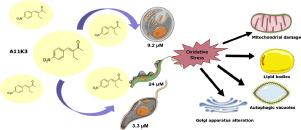Acta Tropica ( IF 2.7 ) Pub Date : 2020-08-08 , DOI: 10.1016/j.actatropica.2020.105653 Jéssica Carreira de Paula 1 , Amanda Beatriz Kawano Bakoshi 1 , Danielle Lazarin-Bidóia 1 , Zia Ud Din 2 , Edson Rodrigues-Filho 2 , Tania Ueda-Nakamura 1 , Celso Vataru Nakamura 1

|
Chagas disease is one of the most prevalent neglected diseases in the world. The illness is caused by Trypanosoma cruzi, a protozoan parasite with a complex life cycle and three morphologically distinct developmental stages. Nowadays, the only treatment is based on two nitro-derivative drugs, benznidazole and nifurtimox, which cause serious side effects. Since the treatment is limited, the search for new treatment options for patients with Chagas disease is highly necessary. In this study we analyzed the substance A11K3, a dibenzylideneacetone (DBA). DBAs have an acyclic dienone attached to aryl groups in both β-positions and studies have shown that they have biological activity against tumors cells, bacteria, and protozoa such as T. cruzi and Leishmania spp. Here we show that A11K3 is active against all three T. cruzi evolutionary forms: the epimastigote (IC50 = 3.3 ± 0.8), the trypomastigote (EC50 = 24 ± 4.3) and the intracellular amastigote (IC50 = 9.3 ± 0.5 µM). A cytotoxicity assay in LLCMK2 cells showed a CC50 of 239.2 ± 15.7 µM giving a selectivity index (CC50/IC50) of 72.7 for epimastigotes, 9.9 for trypomastigotes and 25.9 for intracellular amastigotes. Morphological and ultrastructural analysis of the parasites treated with A11K3 by TEM and SEM revealed alterations in the Golgi complex, mitochondria, plasma membrane and cell body, with an increase of autophagic vacuoles and lipid bodies. Biochemical assays of A11K3-treated T. cruzi showed an increase of ROS, plasma membrane ruptures, lipid peroxidation, mitochondrial membrane depolarization with a decrease in ATP and accumulation of autophagic vacuoles. The results lead to the hypothesis that A11K3 causes death of the protozoan through events such as plasma membrane and mitochondrial alterations and autophagy, characteristic of cell collapse.
中文翻译:

二亚苄基丙酮衍生物(E)-3-乙基-4-(4-硝基苯基)but-3-3-en-2-one在克氏锥虫中的抗增殖活性。
恰加斯病是世界上最流行的被忽视的疾病之一。该病是由克氏锥虫引起的,克氏锥虫是一种原生动物寄生虫,具有复杂的生命周期和三个形态学上不同的发育阶段。如今,唯一的治疗方法是基于两种硝基衍生物药物,苯并硝唑和硝呋替莫,它们会引起严重的副作用。由于治疗的局限性,迫切需要为查加斯病患者寻找新的治疗选择。在这项研究中,我们分析了物质A11K3,一种二亚苄基丙酮(DBA)。DBA在两个β位置的芳基上均具有一个无环二烯酮,并且研究表明它们具有抗肿瘤细胞,细菌和原生动物(如克鲁维氏酵母和利什曼原虫属。在这里,我们显示A11K3对所有三种克鲁氏梭菌的进化形式均具有活性:副鞭毛体(IC 50 = 3.3±0.8),色粉鞭毛体(EC 50 = 24±4.3)和细胞内鞭毛体(IC 50 = 9.3±0.5 µM)。 。LLCMK 2细胞的细胞毒性分析显示,CC 50为239.2±15.7 µM,对前鞭毛鞭毛虫的选择性指数(CC 50 / IC 50)为72.7,对锥鞭毛鞭毛虫的选择性指数为9.9,胞内变形虫为25.9。A11K3处理的寄生虫的形态和超微结构分析透射电镜和扫描电镜显示,高尔基体,线粒体,质膜和细胞体发生改变,自噬泡和脂质体增加。经A11K3处理的克鲁氏梭菌的生化分析显示,ROS升高,质膜破裂,脂质过氧化,线粒体膜去极化,ATP降低以及自噬泡的积累。结果导致这样的假设:A11K3通过质膜和线粒体改变以及自噬(细胞崩溃的特征)等事件导致原生动物死亡。


























 京公网安备 11010802027423号
京公网安备 11010802027423号